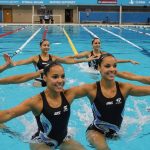A great synchronized swimming performance is a spectacle to behold. It blends artistry, athleticism, and precision into a captivating display of skill and teamwork. A crucial element in this sport is synchronicity – the unison movement that gives the sport its name. Achieving this level of harmony requires rigorous training and relentless practice, especially in underwater drills, which form an integral part of these training regimes.
Underwater drills help to improve endurance, agility, and the precision of movements, all of which are vital in achieving perfect synchronicity. This article explores how synchronized swimming teams can further enhance their synchronicity through these drills.
In parallel : How can professional cricketers enhance their fielding agility?
The Importance of Underwater Drills
Underwater drills are fundamental to the training regimen of synchronized swimmers. They are the backbone of the sport, driving the development of key skills such as breath control, coordination, endurance, and strength.
Underwater drills are not only about repetition but also about mastering each movement to perfection. They are designed to simulate the conditions that swimmers will face during a performance, helping them to maintain their form and stay in sync. Drills also allow coaches to spot any discrepancies in the team’s performance and correct them in real time.
Topic to read : How does altitude training benefit long-distance runners in major marathons?
Breath Control and Endurance
One of the most challenging aspects of synchronized swimming is the ability to control one’s breath while executing complex movements underwater. This is where underwater drills come in handy. Swimming drills such as breath control exercises, underwater swimming, and hypoxic training help improve the swimmers’ ability to hold their breath for extended periods.
The endurance built through these exercises allows swimmers to perform longer routines without compromising on their speed, agility, or synchronicity. Long-distance swimming, interval training, and aerobic conditioning are some of the drills that help build stamina, allowing swimmers to maintain their synchronicity throughout the routine.
Precision and Coordination
Precision and coordination are the hallmarks of a well-executed synchronized swimming routine. Underwater drills are the perfect way to instill these qualities in a synchronized swimming team.
Drills that focus on precision involve repetitive practice of specific movements, both individually and as a team. These exercises help swimmers refine their technique and enhance their ability to execute movements with accuracy.
Team coordination drills, on the other hand, aim to improve the swimmers’ ability to move in perfect harmony with their teammates. These drills can be as simple as swimming in formation, or as complex as executing a full routine together. The critical bit is that all team members practice the same movements simultaneously, fostering a sense of unity and synchronicity.
Strength and Agility
Synchronized swimming demands more than just skill – it requires a significant amount of physical strength and agility. Swimmers need to be strong enough to propel themselves out of the water and agile enough to perform intricate movements with grace and precision. Underwater drills can help develop these physical attributes.
Strength-building drills focus on developing the muscles used in synchronized swimming. This involves a mix of swimming drills and dryland exercises, targeting the core, legs, and upper body. These exercises help improve the swimmers’ propulsion, stability, and control, contributing to better synchronicity.
Agility drills, meanwhile, aim to enhance a swimmer’s fluidity and speed of movement. These drills might involve quick direction changes, complex footwork, and rapid transitions between different movements. By improving agility, these drills help swimmers execute their routines with greater precision and synchronicity.
Incorporating Technology in Underwater Drills
Advancements in technology have opened up new possibilities for improving synchronicity in synchronized swimming. Coaches can now leverage underwater cameras and motion tracking technology to analyze their team’s performance in great detail.
Underwater cameras allow coaches to assess individual and team movements from multiple angles, helping them spot any irregularities or deviations in the team’s synchronicity. Motion tracking technology, on the other hand, offers detailed data on the swimmers’ movements, providing insights on areas that need improvement.
Incorporating technology into underwater drills can significantly enhance their effectiveness, leading to noticeable improvements in the team’s synchronicity.
The Role of Free Routines in Synchronized Swimming
Free routines play a significant role in synchronized swimming, offering swimmers the freedom to showcase their creativity, skill, and synchronicity. In these routines, swimmers are not bound by specific moves or patterns and can perform any move that falls within the rules of the sport.
Performing a free routine requires a high level of coordination and synchronization amongst the team members. Each swimmer must be aware of their position in relation to others and must execute their movements at the exact right moment to maintain the team’s synchronicity.
Underwater drills are an effective way to prepare for these free routines. Through these drills, swimmers can practice their moves in a controlled environment, allowing them to perfect their timing and coordination. Coaches can also use these drills to experiment with new routines and formations, helping the team to constantly innovate and improve.
Even solo and duet teams benefit immensely from underwater drills. A solo duet, for instance, involves two swimmers performing together, and the success of their performance largely depends on their ability to move in perfect unison. Underwater drills allow these swimmers to practice their moves together, helping them to improve their synchronicity and earn a higher final score.
The Influence of Underwater Drills on Olympic Performances
The Olympic Games are the ultimate stage for synchronized swimmers to showcase their talent and hard work. The level of competition is incredibly high, with teams from across the world competing for the coveted gold medal. To stand out, teams must deliver a flawless performance, demonstrating perfect synchronicity and impressive artistic flair.
Underwater drills are an integral part of the preparation for the Olympic Games. Teams spend countless hours practicing their routines underwater, perfecting each movement to ensure that their performance is in complete harmony.
Team USA, for example, is known for its rigorous training regimen, which includes a variety of underwater drills. These drills have played a pivotal role in their success, helping them consistently deliver stunning routines that captivate audiences and impress judges.
However, the benefits of underwater drills extend beyond just improving synchronicity. These drills also help swimmers build the strength and stamina required to perform at an Olympic level. They are a vital part of the training regimen, helping swimmers maintain their form and rhythm even in the face of intense competition and pressure.
Achieving synchronicity in synchronized swimming is no easy feat. It requires a blend of skill, precision, endurance, and strength, all of which can be honed through underwater drills.
Whether it’s improving breath control, enhancing precision and coordination, or building strength and agility, underwater drills provide an effective way for synchronized swimming teams to refine their performance. The incorporation of technology into these drills further enhances their effectiveness, allowing coaches to analyze and improve their team’s synchronicity in great detail.
While the journey to perfect synchronicity is challenging, the rewards are immense. From delivering breathtaking free routines to earning a high final score at the Olympic Games, the benefits of perfect synchronicity are clear. With the right training regimen, featuring a mix of underwater drills, synchronized swimming teams can take their performance to new heights.











